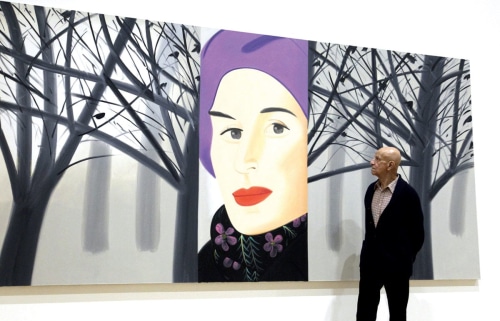
Playing Catch-Up: Alex Katz in front of his painting January 3, 1993, at the Guggenheim Bilbao in 2015.
LUIS TEJIDO/EPA/SHUTTERSTOCK
What’s Next? 18 Trends That Will Move the Art World Forward
By The Editors of ARTnews
June 24, 2020
Alex Katz’s Market Will Catch Up With His Importance
Alex Katz, who this summer turns 93, is poised for liftoff. The Guggenheim Museum is planning a major retrospective, young artists have been looking at his work, and the market is starting to appreciate the artist’s depth.
At auction, the excitement started in February 2019 when, for the first time, one of his paintings passed the $1 million mark. (The 1987 portrait Ada and Louise went for $1.2 million at Christie’s London.) Then, last October, Phillips London reset the record when the 1972 painting Blue Umbrella I soared past its $1.4 million presale estimate to make $4.1 million.
An argument could be made that Katz is as historically important as peers like David Hockney (whose auction record is $91 million) and Gerhard Richter (whose auction record is $46.3 million)—and yet his market has lagged behind theirs. But dealer Thaddaeus Ropac, who has represented Katz for 25 years with his galleries in London, Paris, and Switzerland, has seen a steady rise in interest for the American artist in Europe, starting with institutions and, more recently, private collectors. Ropac’s first show of Katz’s paintings in Paris in the early ’90s “was a total surprise to many Europeans, including museum curators,” he said. The Centre Pompidou, which held works by American peers like Jasper Johns but not one by Katz, bought one. And the fever spread, as Ropac said; at last count he’d sold almost 50 pieces to European institutions, with the Albertina Museum in Vienna acquiring work by the artist in depth.
American institutions have always had strong Katz holdings—the Met alone has works from various periods of his career. But while European museums mounted survey shows, American institutions lagged behind. “For years we were talking to many American institutions, trying to see how they could honor him with a major retrospective,” Ropac said. Then, in January, the Guggenheim announced a Katz retrospective planned for 2022. “The announcement of that show has affected the level of interest in Katz—it has changed the market.”
Other factors have contributed to the resurgence of interest—not least the fact that, at 92, Katz is still painting. And 10 years ago, he made a decision that added a certain currency to his profile when, for his New York representation, he left the well-established Pace Gallery for the younger, hipper Gavin Brown’s Enterprise. (And this even though mega-gallerist Gagosian had expressed interest in taking him on.) Brown has mounted numerous exhibitions of new paintings and sees Katz as capturing the present moment. “To be painting lived and experienced moments at 92 with a fearlessness and a confidence—I don’t know any artist a quarter or a third his age who can do that,” Brown said. “It seems as though with every painting he jumps off the cliff with complete confidence he can fly.”
Brown added, in mind of a legacy still propagating, “young artists and the primary market have great respect and a great response to that. He’s painting in the last period of his life and he is doing it at full speed.”